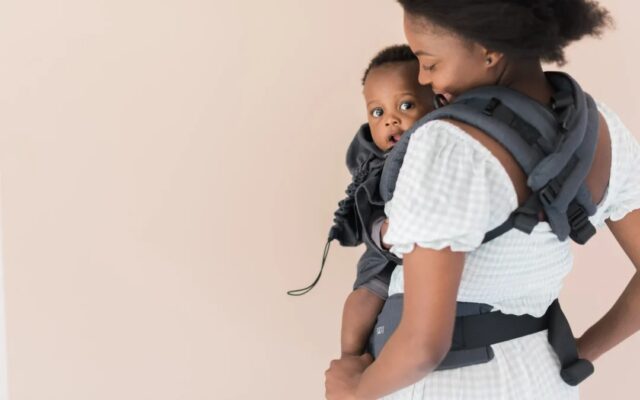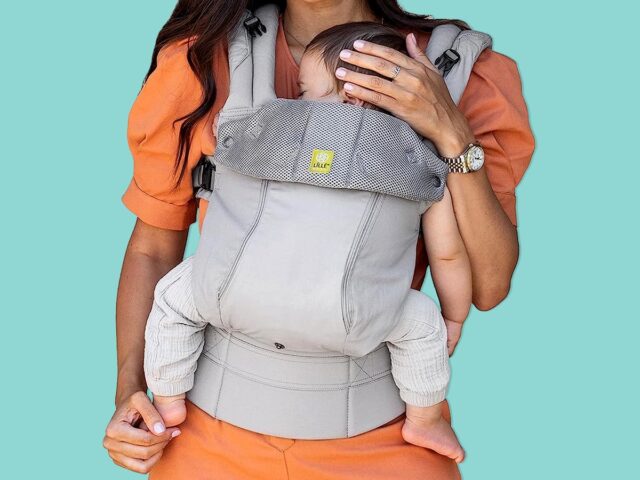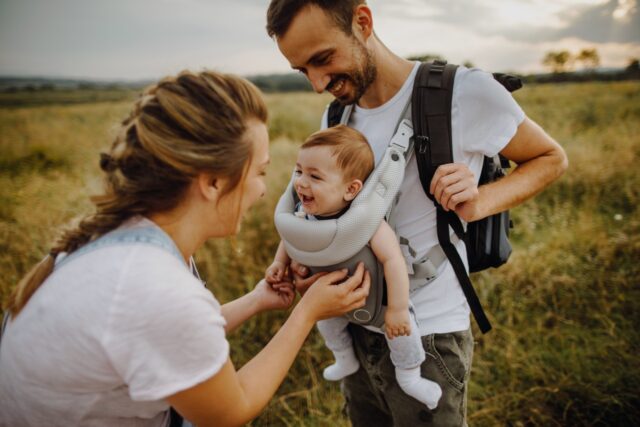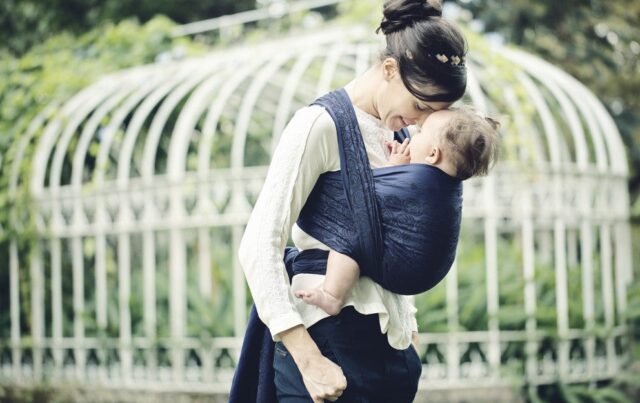
Are you aware that babywearing can strengthen the bond between you and your child while supporting their physical development? It’s not just about convenience; it has emotional and health benefits too.
Key Points:
- Choose the right carrier for comfort and support.
- Check for proper positioning to avoid risks.
- Regularly inspect the carrier for wear and tear.
- Adjust straps to fit snugly and securely.
- Be mindful of your baby’s breathing and visibility.
Choosing the Right Carrier for Comfort and Support

The foundation of safe babywearing starts with the right carrier. It should support both the baby’s hips and spine while offering comfort for the wearer.
Options vary, including wraps, slings, and structured carriers. Each has unique benefits depending on your needs and lifestyle.
When exploring baby carriers, look for those that distribute weight evenly. A padded waistband and shoulder straps can reduce strain. The fabric should be breathable and strong enough to hold your baby securely.
Structured carriers often provide better lumbar support, while wraps offer versatility in carrying styles.
Consider factors like the age of your baby, your activity level, and even the climate. Some carriers come with mesh panels for better airflow, which is great for warmer environments.
Additionally, newborns may benefit from carriers with built-in head support, while older babies enjoy more freedom with outward-facing designs.
What to Look For in a Quality Carrier:
- Strong, durable materials
- Wide, padded straps for comfort
- Adjustable features to grow with your baby
- Certifications for safety standards
How to Position Your Baby Correctly
Correct positioning reduces the risk of discomfort and health issues. A well-positioned baby feels secure and comfortable, which promotes healthy development.
- Tight and secure: Ensure the carrier holds your baby snugly without slouching. Loose carriers can cause strain on the baby’s back and neck.
- In view at all times: You should always see your baby’s face without adjusting. This helps monitor their breathing.
- Close enough to kiss: The baby’s head should be within easy reach. This position not only supports bonding but also helps you detect any signs of distress quickly.
- Keep chin off chest: This prevents airway restriction, allowing the baby to breathe freely.
- Supported back: The carrier should support the natural curve of your baby’s spine. For newborns, ensure their heads have additional support until they develop neck strength.
FUN FACT:
Did you know that correct babywearing can help reduce colic symptoms? Upright positioning helps with digestion and reduces reflux.
Key Safety Checks Before Every Use

Before heading out, run through a quick checklist. Think of it as a pre-flight safety check to ensure everything is secure.
- Inspect the fabric and stitching for signs of wear, like fraying edges or loose threads.
- Check buckles and fasteners to ensure they lock properly without slipping.
- Confirm that the baby’s face is visible, with no fabric covering their nose or mouth.
- Test the tightness by gently leaning forward. Your baby should stay close without pulling away.
- Feel for any pressure points against your baby’s skin, especially around the legs and neck.
Pro Tip:
Keep a small mirror in your diaper bag. It helps check your baby’s face when using back carriers.
Adjusting for Comfort: It’s Not One-Size-Fits-All
Every body is different. What feels comfortable for one parent might not work for another. Adjust straps to fit snugly but comfortably. Your baby should feel secure, but you shouldn’t feel pinched or strained.
- Adjust shoulder straps: They should sit evenly to avoid neck or back pain. Uneven straps can lead to long-term discomfort.
- Balance the waistband: Distribute the baby’s weight across your hips, not just your shoulders. A well-balanced carrier reduces fatigue.
- Test different positions: Some babies prefer facing inward, while others enjoy outward-facing views. As your baby grows, their preferences may change.
Try walking around the house to test adjustments before heading outside. Small tweaks can make a big difference in comfort.
Many new parents find that using the carrier around the house first helps build confidence. This also allows your baby to adjust gradually, creating a positive association.
Recognizing Signs of Discomfort in Your Baby
Babies communicate discomfort in subtle ways. Being attentive to these signs helps prevent issues before they escalate.
- Fussiness beyond normal crying, especially after you’ve ruled out hunger or a dirty diaper.
- Red marks on their skin after removal, indicating pressure points that need adjustment.
- Difficulty breathing or unusual noises, like grunting or wheezing.
- A stiff or limp posture, which could signal poor support.
Quick Tip:
Babies often fall asleep when they’re comfortable. If your baby struggles to settle, it might be time to check their position.
Weather Awareness: Dressing for Babywearing

Your baby will be close to your body heat, which adds warmth. Dressing appropriately prevents overheating or getting too cold.
In Hot Weather:
- Use lightweight, breathable fabrics.
- Keep their head shaded with a hat.
- Check for signs of overheating, like flushed skin or rapid breathing.
In Cold Weather:
- Dress your baby warmly, but avoid bulky clothing inside the carrier.
- Protect exposed areas like hands, feet, and head.
- Use carrier covers or blankets over both of you for extra warmth.
Layering is key. Add or remove layers as needed, and always check your baby’s neck or back to gauge their temperature.
Tips for New Parents to Build Confidence
- Practice at home: Use a mirror to check positioning. Seeing yourself helps correct mistakes early.
- Start with short sessions: Gradually increase the time as you and your baby adjust. Short, positive experiences build confidence.
- Join a local group: Babywearing groups offer support and advice. Meeting other parents can provide reassurance.
- Watch tutorials: Reliable online resources can guide proper techniques. Look for content from certified babywearing educators.
- Listen to your body: If you feel discomfort, adjust the fit. Comfort for you is just as important as comfort for your baby.
Confidence comes with practice. Don’t worry if it feels awkward at first—it gets easier.
Common Mistakes to Avoid
- Incorrect positioning: Can lead to hip dysplasia or breathing issues. Always follow the T.I.C.K.S. rule (Tight, In view, Close enough to kiss, Keep chin off chest, Supported back).
- Ignoring weight limits: Always follow the manufacturer’s recommendations to prevent accidents.
- Over-tightening: Can restrict airflow or cause discomfort. A snug fit doesn’t mean constricting.
- Neglecting regular checks: Wear and tear can compromise safety. Regular inspections keep both you and your baby secure.
Awareness of these mistakes helps you adjust quickly and confidently.
Benefits Beyond Convenience

Babywearing fosters emotional connections, improves baby’s mood, and can even aid in breastfeeding. It supports cognitive development through close interaction and exposure to everyday environments.
- Promotes secure attachment by keeping your baby close.
- Enhances communication through body language, facial expressions, and vocal cues.
- Eases colic and reduces crying due to the soothing motion and upright position.
- Supports healthy hip development when done correctly.
Your baby learns by observing you. Being carried allows them to engage with the world safely.
The Role of Babywearing in Early Development
Carrying your baby regularly supports not just physical growth but emotional and cognitive development. The upright position stimulates their senses, aiding visual and auditory tracking. Close contact helps regulate their heartbeat, breathing, and even body temperature.
Developmental Benefits Include:
- Enhanced balance and motor skills
- Better head control
- Exposure to social interactions
- Strengthened parent-baby bond
Babywearing on the Go: Tips for Travel
Traveling with a baby can be overwhelming, but a good carrier makes it manageable. Airports, public transport, and sightseeing become easier when your hands are free.
Travel Tips:
- Choose lightweight carriers for warmer climates.
- Use carriers with pockets for easy access to essentials.
- Practice hands-free breastfeeding for convenience.
Final Advice for a Positive Experience
Stay flexible. Babies grow and change quickly, and their needs will shift. What works today might need adjusting tomorrow. Be patient with yourself as you learn.
- Trust your instincts. If something feels off, reassess.
- Stay informed. Regularly review guidelines and best practices.
- Enjoy the closeness. It’s a precious time that passes quickly.
Babywearing can be a joyful, bonding experience when approached with care and attention. With the right carrier, proper positioning, and regular safety checks, you can create a secure environment for both you and your baby.









